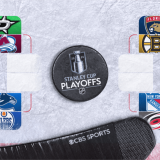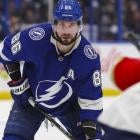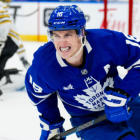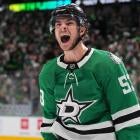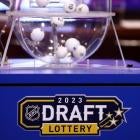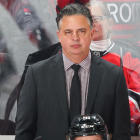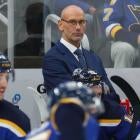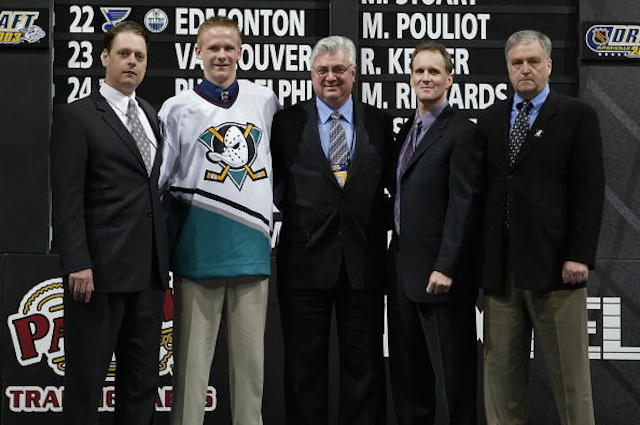
The NHL Draft kicks off Friday night in Florida, where phenom prospects Connor McDavid and Jack Eichel are expected to be the top two picks by the Edmonton Oilers and Buffalo Sabres.
The hype machine around these two has been going strong all season, and they are without question the two most prized players in this year's class (or in any draft class in recent memory). The talk of their skill and upside will no doubt draw comparisons to great players both still in the NHL today and All-Stars and Hall of Famers from the league's past.
But the comparisons in the first round Friday night will not end with them.
Just about every player who gets picked in the first round, whether it's No. 1 spot or No. 30, will probably be compared to a superstar player. Every defenseman with good size and a big shot will be the next Chris Pronger or Zdeno Chara. Every goalie will be a mix of Patrick Roy and Martin Brodeur or be the next Carey Price. Every forward will have gamebreaking ability and be a potential scoring champion.
The reality, though, is that once you get beyond the first few picks in the draft your odds of finding a regular NHLer, let alone a superstar, drop significantly.
To show just how much it drops, we wanted to look at the complete history of the first 30 picks in the NHL Draft and find the most successful player in terms of total games played, goals scored and points recorded in their NHL career.
We also looked at what percentage of players picked in each spot made it to the NHL for at least one game, and what percentage of players played in at least 200 games in their career.
These are the results.
| NHL Draft: History of top-30 picks | |||||
| Pick | Most Games | Most Goals | Most Points | Made NHL | 200 Games |
| 1 | Mike Modano (1,499) | Mario Lemieux (690) | Mario Lemieux (1,723) | 94.2 | 88.4 |
| 2 | Brendan Shanahan (1,524) | Marcel Dionne (731) | Marcel Dionne (1,354) | 92.3 | 82.6 |
| 3 | Glen Wesley (1,457) | Denis Savard (473) | Denis Savard (1,338) | 92.3 | 76.2 |
| 4 | Ron Francis (1,731) | Mike Gartner (708) | Ron Francis (1,798) | 92.3 | 71.5 |
| 5 | Scott Stevens (1,635) | Jaromir Jagr (722) | Jaromir Jagr (1,802) | 92.3 | 63.4 |
| 6 | Phil Housley (1,495) | Vincent Damphouse (432) | Paul Coffey (1,531) | 92.3 | 67.3 |
| 7 | Luke Richardson (1,417) | Bill Barber (420) | Bernie Federko (1,130) | 92.3 | 75.0 |
| 8 | Ray Bourque (1,612) | Jeremy Roenick (513) | Ray Bourque (1,579) | 96.1 | 63.4 |
| 9 | Rod Brind'Amour (1,4848) | Rod Brind'Amour (452) | Rod Brind'Amour (1,184) | 86.5 | 63.4 |
| 10 | Teemu Selanne (1,451) | Teemu Selanne (684) | Teemu Selanne (1,457) | 88.4 | 63.4 |
| 11 | Jarome Iginla (1,392) | Jarome Iginla (589) | Jarome Igilna (1,226) | 84.6 | 61.5 |
| 12 | Gary Roberts (1,224) | Marian Hossa (486) | Marian Hossa (1,056) | 82.6 | 53.8 |
| 13 | Derek Morris (1,107) | Ron Duguay (274) | Craig Janney (751) | 78.8 | 57.6 |
| 14 | Sergei Gonchar (1,301) | Rick Middleton (448) | Brian Propp (1,004) | 90.3 | 61.5 |
| 15 | Al MacInnis (1,416) | Joe Sakic (625) | Joe Sakic (1,641) | 71.1 | 30.7 |
| 16 | Dave Andreychuk (1,639) | Dave Andreychuk (640) | Dave Andreychuk (1,338) | 88.4 | 50.0 |
| 17 | Kevin Hatcher (1,157) | Brent Sutter (363) | Bobby Clarke (1,210) | 82.6 | 55.7 |
| 18 | Ken Daneyko (1,283) | Glen Murray (337) | Petr Sykora (721) | 76.2 | 40.3 |
| 19 | Keith Tkachuk (1,201) | Keith Tkahcuk (538) | Keith Tkahcuk (1,065) | 76.9 | 40.3 |
| 20 | Larry Robinson (1,384) | Michel Goulet (548) | Michel Goulet (1,152) | 82.6 | 48.0 |
| 21 | Kevin Lowe (1,254) | Dennis Maruk (356) | Dennis Maruk (878) | 80.7 | 50.0 |
| 22 | Bryan Trottier (1,279) | Bryan Trottier (524) | Bryan Trottier (1,425) | 80.7 | 42.3 |
| 23 | Ray Whitney (1,330) | Ray Whitney (385) | Ray Whitney (1,064) | 82.6 | 46.1 |
| 24 | Daniel Briere (973) | Daniel Briere (307) | Daniel Briere (696) | 80.7 | 44.2 |
| 25 | Todd Gill (1,007) | Brenden Morrow (265) | Mark Howe (742) | 88.4 | 40.3 |
| 26 | Claude Lemieux (1,215) | Claude Lemieux (379) | Claude Lemieux (786) | 80.7 | 34.6 |
| 27 | Scott Mellanby (1,431) | Joe Nieuwendyk (564) | Joe Nieuwendyk (1,126) | 90.3 | 48.0 |
| 28 | Shean Donovan (951) | Corey Perry (296) | Corey Perry (602) | 82.6 | 30.7 |
| 29 | Teppo Numminen (1,372) | Stephane Richer (421) | Stephane Richer (819) | 84.6 | 28.8 |
| 30 | Randy Carlyle (1,055) | Pat Hickey (192) | Randy Carlyle (647) | 80.7 | 28.8 |
Best-case scenario, there lot of really good players at just about every pick. A lot of Hall of Famers, too.
But those are the best-case scenarios. The picks where everything goes perfectly, from the scouting to the player development staff in the front office to the player himself all coming together and working perfectly to produce a superstar.
When it comes to the overall odds of finding a player to simply stick in the NHL, look at how much the odds drop from the top two to the rest of the top 10, and then from the top 10 through the remainder of the first round. By the time you get down to the Nos. 29 and 30 overall picks, you're looking at less than a 30 percent chance of finding a player that will play at least 200 games in the NHL. Keep in mind that is not a particularly high bar, either, as 200 games isn't even three full seasons worth of games.
Once you get into the second round, especially the later parts of the round, the odds of even getting a player to the NHL drop to less than 50 percent and the hope of getting 200 games drops even more.
The bottom line here is that you should make sure you have reasonable expectations for your team's first-round pick if it is after the 10th or 11th pick. They are not all going to be All-Stars or even regulars in the NHL. No player selected in the 28th spot played more games than Shean Donovan. Claude Lemieux is the best player ever taken 26th overall.
And that brings us to another key point here: Why would any team ever want to trade out of one of the top picks in the draft?
To be fair, it rarely happens, especially in the salary cap era where star players on entry level contracts (the type of players teams find at the top of the draft) are so valuable. But there is always talk of it, and there is one team that seems to be auctioning off its top-five pick this season.
In the salary cap era, only three teams have outright traded a top-10 pick (the Devils traded the 2013 No. 9 pick for Cory Schneider; the Hurricanes traded the 2012 No. 8 pick in a package for Jordan Staal; the Blue Jackets traded the 2011 No. 9 pick in a package for Jeff Carter).
(Note: The Toronto Maple Leafs ended up trading the 2011 No. 2 overall pick to Boston in the Phil Kessel trade, but at the time of the trade the exact pick was not known -- it was simply a future first-round pick).
Only three other teams -- the 2008 New York Islanders, the 2007 St. Louis Blues and the 2005 Atlanta Thrashers -- traded out of the top 10 for more picks later in the draft, with only the Islanders' pick (No. 5 overall) coming in the top five.
• The Islanders sent their 2008 No. 5 pick to Toronto for the No. 7 pick and two conditional draft picks. The Maple Leafs selected Luke Schenn while the Islanders traded down again and ended up with Josh Bailey.
• In 2007, the Blues sent the No. 9 pick to San Jose for the Nos. 13 and 44 picks. The Sharks ended up with Logan Couture in the top 10 while the Blues used their two picks to select Lars Eller and Aaron Palushaj.
• In 2005, the Thrashers sent the No. 8 pick to San Jose for the Nos. 12, 49 and 207 picks. The Sharks ended up with Devin Setoguchi at No. 8, while the Thrashers traded down again with the Rangers (moving from No. 12 to 16 while gaining the No. 41 pick). The Rangers selected Marc Staal, the Thrashers ended up with Alex Bourett and Ondrej Pavelec.
Heading into Friday the Arizona Coyotes, owners of the No. 3 pick, have been the team that has generated the most trade interest, and general manager Don Maloney has been extremely open about his trade talks. It's to the point now where it almost seems as if he is just simply trying to create more interest for the pick in the hopes of creating a bidding war for the pick. On Thursday he went as far as to say that one team has offered two mid-first-round picks and an NHL player for the No. 3 pick.
Let's assume that really happened and it isn't just a GM trying to drive up the price of his asset.
The only teams other than Arizona with multiple picks in the first round this year are Edmonton (1 and 16), Buffalo (2 and 21), Toronto (4 and 24), Winnipeg (17 and 25) and Philadelphia (7 and 29). The only teams that fit the criteria that Maloney described are Winnipeg and Philadelphia, and it would most likely be Winnipeg.
This is one of those cases where quality means a heck of a lot more than quantity, and that would have to be one heck of an NHL player for Arizona to consider moving back 14 spots in the first round, going from the No. 3 spot where they still have a pretty solid chance to land an All-Star to the middle of the first round where they have a 50 percent chance of finding a player who can play two-and-a-half seasons in the NHL.
Superstars win games and championships. And you find superstars at the top of the draft.












